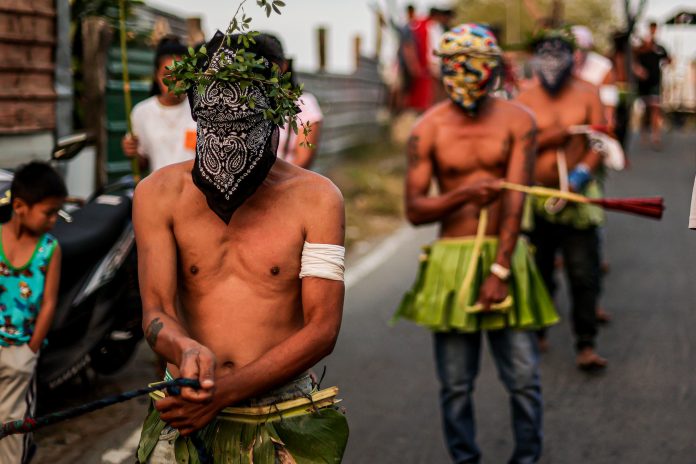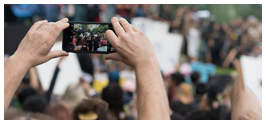Journalists describe Philippine Christianity as “Calvary Catholicism,” and theologians also point to the strong popular devotion to the suffering and crucified Jesus as the main hallmark of Filipino religiosity. This reaches its peak during Holy Week with its many practices, both liturgical and popular — inside churches, on the streets, or on mountaintops.
We see people following the Stations of the Cross, doing pabasa or Visita Iglesia — in all kinds and forms. Some flagellate themselves or have others whip them while they carry the cross. But what catches worldwide media attention are the ‘crucifixion rituals’ on Good Friday, done in at least two places in the provinces of Pampanga and Bulacan.
Mainstream churches distance themselves from many of these practices. Priests and pastors condemn them as abuses or distortions of the faith. But despite the warnings, thousands of ordinary faithful still flock to these curious celebrations of faith.
The ritual ‘nailing on the cross’ is the climax of the whole-day reenactment of the Way of Jesus to Calvary called the sinakulo — a contextualized form of European passion plays. This performance, whose stage is the whole village, is participated in by local inhabitants, each one donning Jewish or Roman costumes.
The lead role of the Kristo (Christ) can be taken by men or women. In Pampanga, the role is mostly taken by men; in Bulacan, mostly by women. For some time, there was only one who performed Christ’s role. Recently, they permit several persons with a vow to be nailed simultaneously with him.
The day starts with the capture and sentencing of Jesus. He is then made to take a heavy wooden cross, and along the way, he is whipped by the ‘Roman soldiers.’ He also meets his mother, Mary Magdalene, Veronica, Simon of Cyrene, etc.
Along the streets are self-flagellants walking for miles while continually whipping their bloodied bodies. In many homes, the Pasyon – a vernacular verse form of the history of salvation centered on Jesus’ passion, death, and resurrection – is sung by the young and old from Holy Monday onward. All these activities form the immediate context of the ‘crucifixion’ ritual. When the Kristo reaches the Kalbaryo (Mount Calvary), he is nailed, and after 15 minutes of silent prayer amidst cries of pain on top of the cross, he is hurled down and, together with all the participants, proceeds to the home of the day’s sponsor to join in a prepared banquet as a celebration of God’s redemption.
THE PERFORMANCE OF SUFFERING AND PAIN
From being a medieval private practice inside monastic cells, self-flagellation has been performed and ‘staged’ on the streets by poor and ordinary Filipino Christians, most of whom are not regular churchgoers. It has survived as a popular practice for three centuries despite prohibitions by leaders of the institutional Church. The crucifixion ritual is a later development of this penitential spirit but also serves as its most spectacular expression. Crucial to this practice is the sincerity of one’s panata, and to take on the lead role of Kristo, one has to pass through strict screening.
When two European students once volunteered to be nailed as part of their thesis, they were rejected outright. The intention of the vows could range from the petition for healing of a family member, a thanksgiving for a granted prayer, or an act of repentance for a grave wrong one has committed. One Kristo does this as an act of gratitude to God for saving him after a hard fall from a tall building he was painting; another does it as an act of penance for accidentally killing his brother-in-law. This ritual performance of pain and suffering is seen by its participants as a more effective way of achieving inner peace than the sacraments. By being ‘Christ’ and by performing his suffering, one becomes effectively united with him and granted one’s deepest desires for a better life.
These ‘deepest desires’ are not usually for oneself but for others. Most women who are ‘crucified’ are healers – a gift they exercise in the service of their respective communities for free. They believe that the crucifixion ritual is a way to empower them to become better healers through their deep identification with Christ and, in such a transcending act, are also made to share in his divine powers.
CRUCIFIXION RITUAL AS EMPOWERMENT AND RESISTANCE
The bloody death or total destruction of the victim has been a decisive element in the understanding of sacrifice – a dimension viewed as objectionable to many contemporary sensibilities. But our short examination of some sacrificial rituals on Holy Week tells us of rather mixed and incongruous gestures defying systematic categorization: a curious blend of death and life, of pain and jubilation, of humiliation and glory.
In Kalbaryo of Barangay Cutud, Pampanga, one hears loud cries and weeping on the cross, while background music plays “Regina Coeli laetare. Alleluia.” While Christ is hurled down from the cross and treated in an ambulance near the crucifixion site, the rest of the cast goes to the house of the day’s sponsor to share in the meal celebrating God’s redemption and resurrection. How do these opposites co-exist? How can we celebrate Easter on Good Friday? How can suffering co-exist with victory?
Victor Turner’s notion of liminality might be helpful in this regard (Turner, 1969). In installation rites, for instance, the chief-to-be undergoes a liminal event where he is ritually ‘humbled like a slave’ and is self-stigmatized. This marginal (limen) stage of the rites of passage, situated at the threshold between one’s previous status and one’s new calling, serves to remind the future king that his powers are not for self-aggrandizement but for the service of the tribe. In these ambiguous liminal spaces co-exist nothingness and possibilities, servanthood and leadership, dying to self and empowerment.
It is observed that those who undergo the ‘crucifixion’ and passion rituals – mostly poor and marginalized – do not merely fulfill a personal vow. They also aim to gain ‘spiritual powers’ to heal. We still see this among healers who flock to Banahaw on Good Friday. In colonial times, Filipino revolutionaries underwent extreme forms of asceticism or ritual abstinence in order to accumulate power necessary for resistance into their bodies and their inner selves (Ileto, 1979, p. 24).
In their liminal existence marked by acts of self-stigmatization, these present-day healers, too, are transformed and empowered toward a fuller existence, not only for themselves but for their communities.
Recent ritual studies, however, show that rituals, like all practices, are not only mechanisms of hegemonic control but also strategies for transformation. Catherine Bell (1992), for instance, views ritual as “redemptive hegemony,” where “reality is experienced as a natural weave of constraint and possibility, the fabric of day-to-day dispositions and decisions experienced as a field of strategic action.”
Through ritualization, the participants manage, within established limits, to tactically reconfigure power in the social space toward some liberating vision. In some cases in the Philippines today, ritual crucifixions also express political messages – as protest against an unjust landlord or as a prayer for an honest election.
But even without these explicit political intentions, the healing activities at the margins done by empowered men and women healers, and their ascetic, self-sacrificial lives, become signs of transformative resistance as they call into question the sacramental – but also the political – monopoly of a dominant religion in collusion with hegemonic political power.
KILLING THE POOR
But in recent years in the Philippines, thousands are not only ritually crucified but truly killed on the streets or inside their homes and neighborhoods — sometimes in front of their own wives and children.
Like the crucifixion rituals, killings in the War on Drugs also have their own rituals. There is a list of wanted drug users or pushers; there is a frantic search by the police and their cohorts; there is abusive questioning; followed by killings with pistols even before the questions are answered — much less before trial, not even a mocked one.
Once killed, a packet of shabu is placed in one hand, and a pistol in the other. Photos are taken and reported in newspapers as “nanlaban.” In some instances, faces of the murdered are masked with tape, and a cardboard is placed on the crime scene reading “Addict, huwag tularan” — not so different from what Pilate placed on top of Jesus’ cross — “Jesus Nazarenus, Rex Iudaeorum.”
But unlike the passion rituals, these events are not reenactments or liturgical ritualizations. The crucifixion is for real. Their victims were truly killed and murdered. We now pray that they will soon be vindicated. Like Jesus — on the third day.
Father Daniel Franklin Pilario, C.M., is the President of Adamson University in Manila. He is a theologian, professor, and pastor of an urban poor community on the outskirts of the Philippine capital. He is also Vincentian Chair for Social Justice at St. John’s University in New York.









